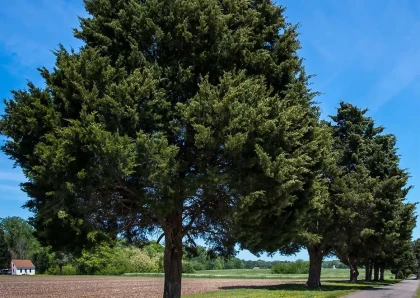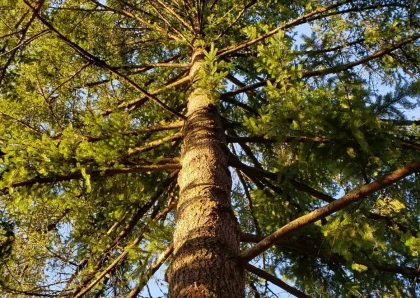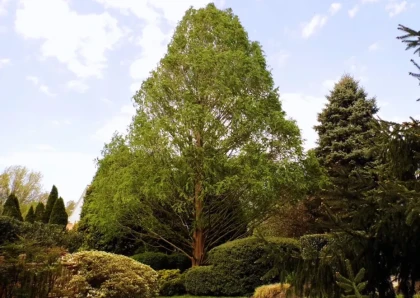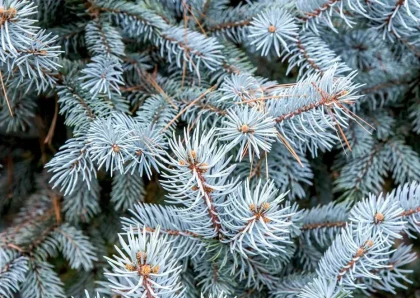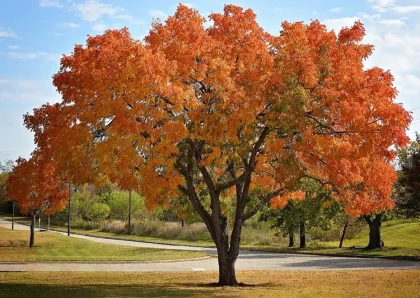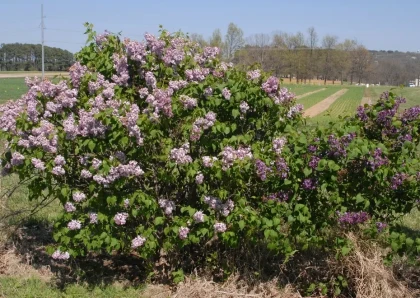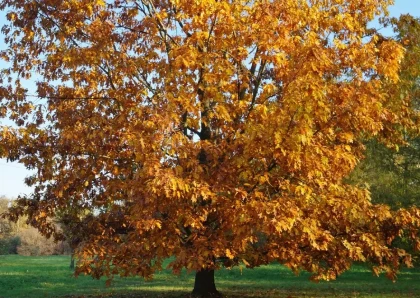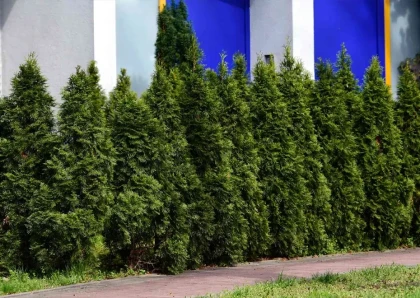
Deodar Cedar Tree
Overview
The name "Deodar" is derived from the Sanskrit words "deva" (meaning "god") and "daru" (meaning "wood" or "tree"), hence it is often referred to as the "Tree of the Gods" or "Timber of the Gods." The Deodar Cedar has a majestic and awe-inspiring appearance, making it a popular choice for ornamental and landscaping purposes in various parts of the world.
Key characteristics of the Deodar Cedar include:
- Size: It is a large tree that can reach heights of up to 40-60 meters (131-197 feet).
- Shape: The tree has a pyramidal shape when young, but as it matures, it develops a more open and spreading crown.
- Needles: The needles are arranged in clusters and are usually blue-green or silvery-blue in color. They can grow up to 2.5-5 cm (1-2 inches) long.
- Cones: The cones are barrel-shaped, about 7-12 cm (3-5 inches) long, and have a greenish-brown color. They take about two years to mature and release their seeds.
- Bark: The bark is thick, rough, and brownish-gray in color, adding to the tree's majestic appearance.
Different types of wood products can be made from Deodar Cedar Tree
Lumber: Deodar Cedar wood is used to produce lumber, which is widely used in construction for various purposes like beams, posts, joists, rafters, and framing. It is known for its strength, durability, and resistance to decay.
Furniture: The wood of Deodar Cedar is often used to make high-quality furniture items like tables, chairs, cabinets, and chests. Its attractive grain pattern and pleasant aroma make it a popular choice for fine woodworking.
Doors and Windows: Deodar Cedar wood is used for crafting doors and window frames. It provides an elegant look and can be carved intricately for decorative purposes.
Panelling: Deodar Cedar is used in interior wall panelling due to its beautiful appearance and natural resistance to insects and decay.
Decking and Outdoor Structures: Deodar Cedar lumber is suitable for outdoor applications like decking, pergolas, and gazebos. Its natural resistance to weathering and decay makes it a good choice for these structures.
Roof Shingles: The wood of Deodar Cedar is also used to make wooden roof shingles, which provide an attractive roofing material option.
Sculptures and Carvings: The fine-grained and workable nature of Deodar Cedar wood makes it suitable for carving intricate sculptures and decorative elements.
Musical Instruments: The wood is also used in the construction of musical instruments like acoustic guitars and other stringed instruments due to its resonance properties.
Utility Poles and Fencing: Deodar Cedar is used for making utility poles and fencing due to its strength and resistance to decay.
Aromatic Products: The wood and essential oils extracted from Deodar Cedar are used in the production of aromatic products like incense sticks, fragrances, and oils.
Benefits of Deodar Cedar Tree
- Ornamental Value: Deodar Cedar is renowned for its majestic and awe-inspiring appearance, with its pyramid-shaped crown and graceful, drooping branches. It is widely planted as an ornamental tree in parks, gardens, and landscapes for its aesthetic appeal and ability to enhance the overall beauty of the surroundings.
- Shade and Cooling: The large size and dense canopy of Deodar Cedar provide excellent shade, helping to reduce the intensity of sunlight and cooling the surrounding environment. This is particularly beneficial in urban areas and hot climates.
- Erosion Control: Deodar Cedar's extensive root system helps stabilize soil on steep slopes and hillsides, acting as a natural erosion control measure. This is crucial for preventing soil erosion and landslides in mountainous regions.
- Habitat and Biodiversity: The Deodar Cedar tree provides habitat and shelter for various wildlife species, including birds, insects, and small mammals. It contributes to the overall biodiversity of the ecosystems where it grows.
- Timber and Wood Products: Deodar Cedar wood is highly valued for its strength, durability, and resistance to decay. It is used in the construction of various wood products, such as lumber, furniture, doors, windows, and more.
- Medicinal Properties: In traditional medicine systems, various parts of the Deodar Cedar tree, including its leaves, bark, and essential oils, have been used for their medicinal properties. They are believed to possess antimicrobial and anti-inflammatory properties.
- Aromatic Uses: The wood and essential oils obtained from Deodar Cedar have a pleasant aroma, making them suitable for use in incense sticks, fragrances, and aromatic products.
- Carbon Sequestration: As a large, long-lived tree, Deodar Cedar plays a role in sequestering carbon dioxide from the atmosphere, helping to mitigate the impacts of climate change.
- Cultural and Religious Significance: In its native regions, the Deodar Cedar tree holds cultural and religious significance. It is often associated with spiritual practices and is considered sacred in some cultures.
- Tourism and Recreation: In areas where Deodar Cedar forests are prevalent, they attract tourists and outdoor enthusiasts who visit for trekking, hiking, and nature appreciation, contributing to local economies.
Tips for Planting and Maintaining Deodar Cedar Tree
- Choose a Suitable Location: Select a location with full sun exposure and well-draining soil for planting the Deodar Cedar tree. Ensure it has enough space to grow to its full size without being crowded by other trees or structures.
- Planting: Dig a hole slightly larger than the root ball of the Deodar Cedar. Place the tree in the hole and backfill it with soil, ensuring the tree is planted at the same depth it was in the nursery. Water the tree thoroughly after planting.
- Watering: Deodar Cedar trees prefer consistent moisture during their establishment period. Water the tree deeply and regularly, especially during dry spells. Once established, the tree can tolerate some drought, but it's essential to provide adequate water during prolonged dry periods.
- Mulching: Apply a layer of mulch around the base of the tree to retain moisture, regulate soil temperature, and suppress weed growth. Keep the mulch a few inches away from the trunk to prevent rotting.
- Pruning: Minimal pruning is generally required for Deodar Cedar trees. Remove any dead, damaged, or diseased branches as needed. Avoid heavy pruning, especially in the upper part of the tree, as it can disrupt the natural shape and beauty of the tree.
- Fertilizing: Deodar Cedar trees usually grow well in nutrient-rich soils and may not require frequent fertilization. However, if the soil is deficient in nutrients, you can apply a balanced fertilizer in early spring or fall, following the manufacturer's instructions.
- Pest and Disease Control: Monitor the tree regularly for any signs of pests or diseases. If detected, take appropriate measures to control them, which may include using insecticides or seeking professional advice for severe infestations.
- Winter Protection: In colder climates, young Deodar Cedar trees may benefit from winter protection. You can wrap the tree in burlap or use tree shelters to shield it from harsh winds and extreme temperatures.
- Regular Inspection: Regularly inspect the tree for any issues, such as broken branches or signs of stress. Early detection and prompt action can help maintain the health and longevity of the Deodar Cedar tree.
Cons of Planting Deodar Cedar Tree
- Large Size: Deodar Cedar trees can grow to be quite large, which may not be suitable for smaller landscapes or urban areas with limited space. Planting them too close to buildings or other structures may cause problems as they mature.
- High Water Requirements: Deodar Cedars have high water requirements, especially during their establishment phase. In regions with limited water resources or in drought-prone areas, it may be challenging to meet their water needs.
- Need for Well-Draining Soil: Deodar Cedar trees prefer well-draining soil. Planting them in poorly drained or waterlogged soils can lead to root rot and other health issues for the tree.
- Susceptibility to Pests and Diseases: Deodar Cedars can be susceptible to certain pests and diseases, such as aphids, scale insects, and root rot. Regular monitoring and appropriate pest control measures may be necessary to maintain tree health.
- Leaf Drop: Deodar Cedars are evergreen trees, but they do shed some of their older inner needles. This can create some litter and maintenance work, especially if the tree is planted near pathways or patios.
- Environmental Impact: In regions where Deodar Cedar trees are not native, planting them may have environmental impacts. These trees may outcompete and displace native plant species, affecting the local ecosystem and biodiversity.
- Allergenic Potential: Some individuals may be sensitive to the pollen or aromatic compounds released by Deodar Cedar trees, leading to allergic reactions or respiratory issues in susceptible individuals.
- Long-Term Commitment: Deodar Cedar trees are long-lived, and once planted, they can remain in the landscape for many decades. This is a long-term commitment, and careful consideration should be given to whether the tree's size and characteristics align with future landscape plans.
- Pruning Challenges: As Deodar Cedars grow large, pruning them can be challenging, especially if the tree has not been properly maintained from a young age. Heavy pruning may alter the tree's natural shape and compromise its overall beauty.
- Invasive Potential: In regions where Deodar Cedar trees are not native, there may be concerns about their invasive potential and their impact on native ecosystems. It is essential to plant trees responsibly and consider the ecological implications.
Conclusion
In conclusion, the Deodar Cedar tree is a remarkable and valuable species, cherished for its natural beauty, versatility, and cultural significance. When planted and maintained responsibly, it can enrich landscapes, provide shelter for wildlife, and serve as a symbol of strength and resilience in the natural world. As with any tree, thoughtful consideration of its suitability to the environment and long-term care is essential to ensure its continued benefits and preservation for generations to come.
FAQs
What is a Deodar Cedar tree?
The Deodar Cedar tree, scientifically known as Cedrus deodara, is an evergreen coniferous tree native to the western Himalayas. It is famous for its majestic appearance, with a pyramid-shaped crown and drooping branches.
Why is it called the "Tree of the Gods"?
The name "Deodar" is derived from the Sanskrit words "deva" (meaning "god") and "daru" (meaning "wood" or "tree"). This name reflects its significance in local cultures, often referred to as the "Tree of the Gods" or "Timber of the Gods."
What are the key characteristics of the Deodar Cedar tree?
The Deodar Cedar is a large tree that can reach heights of up to 40-60 meters (131-197 feet). It has a pyramidal shape when young, but as it matures, it develops a more open and spreading crown. The needles are usually blue-green or silvery-blue and can grow up to 2.5-5 cm (1-2 inches) long. The cones are barrel-shaped, about 7-12 cm (3-5 inches) long, and have a greenish-brown color.
What are the benefits of planting Deodar Cedar trees?
Planting Deodar Cedar trees provides several benefits, such as enhancing the aesthetics of landscapes with their majestic appearance, offering shade and cooling, stabilizing soil on slopes to control erosion, and providing habitat for wildlife. The wood of Deodar Cedar is also highly valued for its strength and durability, used in construction and various wood products.
How do you care for a Deodar Cedar tree?
Proper care for a Deodar Cedar tree includes planting it in a location with full sun exposure and well-draining soil. Water the tree deeply and regularly, especially during its establishment phase. Mulching around the base of the tree can help retain moisture and regulate soil temperature. Minimal pruning is usually required, and pest and disease control should be monitored. In colder climates, young trees may benefit from winter protection.
Can Deodar Cedar trees be grown in all climates?
Deodar Cedar trees thrive in temperate to subtropical climates with moderate to high rainfall. They prefer areas with cool winters and warm summers. While they are adaptable to a range of conditions, they may not perform well in extreme cold or hot climates.
Are Deodar Cedar trees invasive?
Deodar Cedar trees are not considered invasive in their native regions. However, when planted in non-native areas, they may potentially outcompete native plant species and impact local ecosystems. It's essential to plant trees responsibly and consider their ecological implications.
Can Deodar Cedar trees be used for lumber and woodworking?
Yes, Deodar Cedar wood is highly valued for its strength, durability, and resistance to decay. It is commonly used in construction for lumber, furniture, doors, windows, and other woodworking applications.




